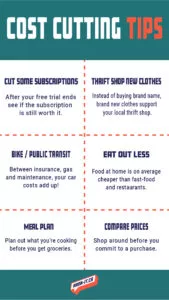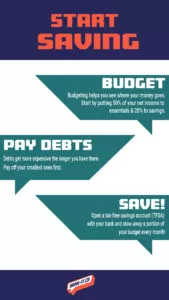
How to Save Money: 25 Top Money Saving Tips
For this guide, we listed the 25+ best ways to save money considering realistic situations so you can successfully start making smarter financial decisions.
Money can’t buy happiness. However, not having enough money is one of the biggest stressors for Canadians. A 2020 report for the Canadian Payroll Association stated that 43% of Canadians are financially stressed, while only 22% consider themselves comfortable.
While everyone could use a raise to help them build savings, this might not be likely for all. Learning financial literacy and building up your own savings on the other hand can be all up to you. It can be hard, but we all need to start somewhere. For more money related articles, check out our Finance section on our site!
Why is it Important to Save Money?
Saving money can get you where you want to be in life. Whether you want to own your own home, go on a dream vacation, or retire one day, saving money can help you get there. Many of these things are way too expensive to accomplish on short term savings, and unless you are fortunate enough to make a large amount of money, you will need to work towards these goals for a while before being able to be able to accomplish them financially.
Beyond that, emergency savings is a very important thing to have just in case. Savings can help you urgently get you out of a desperate situation, helps you avoid taking on debt, and gives you a greater sense of financial freedom.
According to 2019’s BDO Canada Affordability Index, 53% of Canadians live paycheque to paycheque. A survey from the Canadian Payroll Association in 2020 report 37% of Canadians living paycheque to paycheque. Regardless what the number really is, it is clear that many Canadians are struggling when it comes to saving money.
25 Tips to Save More Money
1. Set up a budget and know where your money goes
If your money seems to come and go, you likely need to reassess your spending habits. Small daily purchases add up, and the amount you spend on smaller purchases, or things you do not need, can be significant.
What works for many is to set up a monthly budget, accounting for your needs, like rent or mortgage, consistent bill payments, and groceries, as well as a budget for things you might not need, but want. Ideally, you want to leave a good amount of your income to go into your savings. We recommend looking into the 50/30/20 rule as a solid basis to start your budget – allocating 50% of your after-tax income on your needs, 30% on your wants, and 20% on savings.
How to keep track of it all? Many look to keeping spreadsheets like Microsoft Excel or Google Sheets, however for a more complete experience, you can look into apps like YNAB or Goodbudget – a subscription based and free budgeting app, respectively.
2. Open a Tax-Free Savings Account (TFSA)
Tax-free savings accounts are tax exempt accounts with a name that is a little bit of a misnomer, since they are an investment vehicle that can hold not only saved money, but bonds, stocks, mutual funds, exchange traded funds, and more inside. Being tax-exempt means that you can invest your post-tax money into it, and not have to pay additional tax on any gains that you will see in your account. Since gains on investment returns are typically treated as income, you can pay significant tax on these gains in other types of accounts that can hold investments. Using a TFSA makes sense for many low-income earners to invest, especially if you expect to earn more down the line. TFSA’s also make sense if you will need to withdraw money before a set date, like when you plan on retiring, or for storing in the short term. Just be wary of maximum contributions – if you have never contributed to a TFSA and have lived in Canada since you were 18, then your limit is $52,000. Each year, you get approximately $6,000 more room to put in your TFSA. If you exceed this, you might expect a call from the CRA.

Infographic: Cost Cutting Tips (Infographic: Rank-it.ca)
3. Automate your savings
Once your paycheque has made its way into your chequing account, one of the biggest enemies of your savings is surprising: its you. Some people are prone to impulse purchases (myself especially). Automating your savings removes this factor from your savings, while simultaneously allowing you to worry about your finances less.
So how does it work? Your financial institution likely will have the ability to set up automatic transfers and deposits into your accounts. You can do this any way you want, but a recommended framework to work in is as follows.
First, if you have an employer retirement account, some money from your paycheque will likely come out of your account. If not, and your employer offers this option, you should take that up. When your paycheque then deposits into your chequing account, you can then set it up to automatically send money to other accounts for your savings accounts and investment accounts. Most often, you will choose a sum for any automatic transaction you authorize. You can set up bill pay through your financial institutions to pay rent or any bills too. Bill pay takes a cheque from your account and sends it over to your landlord or anyone else you can pay via cheque.
4. Start investing using robo-advisors
Let’s say you have an emergency fund accumulated, and you want to make your money work for you to potentially acquire more money. There are many ways you can begin to invest your extra money, but one of the easiest is using a robo-advisor. Robo-advisors are automated, allowing you to sit back and just deposit money regularly, and ideally, your savings will grow.
Since robo-advisors are programs, the fees attached to robo-advisors are modest, compared to similar services via banks. You can save that fee by manually doing all your investing, but for an easy investing strategy that can and typically does outperform active investing done by major banks, robo-advisors have established their place in the investing world and are not going anywhere soon.
We wrote a list of the top Robo-advisors and their associated fees.
5. Pay off debt
Paying off debt may hurt your savings in the short term, but long term, it is a very smart idea. Since debts will grow bigger as they accrue interest, paying off any debts you may have should be one of the first things you consider on your journey to financial responsibility. Too many debts to pay off at once? Financial advisors typically advise “the snowball method,” where you pay off the smaller or high-interest debts in full before tackling the largest debts and ascending to the next lowest debt after each is paid off in full. This lets you reduce the amount of sources you are paying interest on, and in many situations lessen your overall debt. However, this rule does not apply to all situations, and it is worth doing the calculations yourself or getting a professional to help figure what debt repayment strategy is right for you.
6. Compare prices and rates using appsand online services
Your monthly bills and expenses are an unfortunate fact of life, but you can likely save some extra money if you know where to look. For your residential energy needs, EnergyRates.ca is a non-biased energy comparison website dedicated to saving you the most money on your energy bills. PlanHub finds you the cheapest phone bill for what you need. Gasbuddy is a website that compares local gas prices and lets you easily save money on gas without going too far out of your way. You can also look for brokers for insurance, mortgages and more online as well.
7. Get a side gig
It is kind of obvious that you can see more savings from increasing your income, however for many people, getting a second job is not in the cards. Whether you have kids or pets that you need to take care of, have outside commitments, or want to maintain your work/life balance, it is understandable that you do not want to get a second or third job.
However, there is a myriad of ways to add supplemental income. You can look online to fill out surveys on swagbucks, complete artistic tasks for others on fiverr, sell crafts on Etsy. Car owners can sign up for SkipTheDishes for food deliveries or Uber for both food delivery or ride sharing. You can take dogs for a walk on Rover. There are simply many ways that you can turn your skills into extra income online.

8. Stop paying unnecessary fees
There are many financial products offered by the big banks, including many different bank accounts, credit and debit cards, and more. However, there are a lot of fees and charges associated with many of these services, that is eating into your savings. More online banks like Tangerine have popped up with a business model that trades the convenience of brick-and-mortar locations of the big banks with an online-only experience that skips the fees.
This goes for your credit card too. Some credit cards have fees, so you might consider switching to a no-fee credit card. You can also look into a credit card that has fees, but a worthwhile cash back or rewards program, so your credit card use can earn you money back.
9. Cancel unnecessary subscription services and memberships
How many streaming services do you have? Have you signed up for any subscription services on a promotional deal, only to be charged when the promotional period has ended? Keeping on top of your subscriptions and memberships can keep your monthly and yearly bills low and will not surprise you when checking your credit card statement.
One of the best ways to keep on top of your subscriptions and memberships is by scanning your credit cards and keep track of them. Think about if you really need each subscription and cancel those you do not need.
10. Cut your cable (really!)
Adding on to the last point, you can save a lot of money by getting rid of cable in lieu of streaming services and other online content.
11. Sell unwanted items
There are many items in your house that are worth money, as long as you find a buyer. With sites like Kijiji and Facebook Marketplace, you can potentially find buyers for your unwanted items quickly.
Of course, not everything you own will be valuable, and you might not necessarily find a buyer. Some things will have more liquid value than others. Items in ideal conditions with value, like furniture, clothes, electronics and collectables might find buyers quicker than other items you might be looking to sell. If you have collected a lot of items, you can consider holding a garage sale, if laws in your area permit it.
12. Reduce household costs
One of the needs you have to account for each month are household costs. These need to be paid before you can put any money away for your savings. Utilities may be included in your rent costs, or you may be responsible for paying each off individually. Other monthly costs, like food and cleaning products, can add into the equation. If you do not have enough money after paying off the essential household costs each month, you might seriously need to consider reducing these costs. Things you can do to reduce these household costs include:
- Shop around for the cheapest utilities, if able.
- Another good way to save money on household costs is to make better use of your utilities. Save on electricity bills by turning off lights and unplug electronics when not in use, take shorter showers and use less water, and throw on a sweater instead of turning up the thermostat.
- Eat smarter and reduce food waste. Food waste is one of the biggest problems of our modern world. According to Waste Reduction Week, the average Canadian household wastes $1,766 in food waste each year. If you can prevent food waste by freezing, vacuum sealing, reusing leftovers, and overall being more cognitive of your food waste can save you big money.
13. Thrift your clothes
Buying name brand clothes of the rack can be an expensive price to look good, and more affordable fashion retailers that dabble in fast fashion have a huge environmental impact. Thrift shopping for your outfits is a cheaper, and overall more environmentally conscious way to fill your closet. You are likely to find a wide selection of clothes, in a wide range of styles, all for an affordable price. You might need to spend some time looking for the perfect outfit, since there will be a lot of clothing you will not want, but the diamond in the rough exists. Don’t believe me? I have found a pair of new Timberland boots – my size – for $15, and found perfect fitting Levi jeans in good condition for a similar price. Hit your local Goodwill instead of the mall next time, and you can see some nice savings that you can throw into your savings or investment accounts.

14. Declutter and adopt a more minimalist lifestyle
Another lifestyle change that can potentially save you money, decluttering and moving toward minimalism might be a big change that could save you money. This change in lifestyle can refocus how you organize your home, improve your finances, and change your outlook on consumerism and spending. However, the savings impact you can see from this tip might be less immediate.
There are some immediate benefits that taking on this lifestyle could have.
With less items in your home, the less storage space you will have, meaning you can spend less on shelving units and storage containers. With less items, you could potentially downsize your living space if you rent, reducing costs which makes frugal living in Canada easier. The biggest item of note with this lifestyle change is that you will ideally be less obligated to buy unnecessary items that you do not need.
15. Invest in online education and expand your skillset for a low cost
Another thing you can do to boost your savings by boosting your wage, learning new skills and education can help you work towards a higher paying job.
Khan Academy, TED-Ed, or Codeacademy are all ways for you to boost your knowledge base for free. These sites employ videos with experts on different topics, although Codeacademy is primarily for learning coding. Masterclass, Skillshare and Udemy are paid services that primarily use videos to teach a broad range of topics, with knowledgeable experts teaching the course – with Masterclass including lessons from working professionals and celebrities you are sure to know. Additionally, almost all universities will have online courses available, which while costing significantly more money, overall looks better on a resume.
16. Use public transport more often or ride a bike
Car payments, insurance, gas, and regular maintenance are a handful of expenses related to owning and using a motor vehicle. While a car is essential for the livelihood for many Canadians, many Canadians are realizing that vehicles are increasingly unecessary. If you can, using public transport, or alternatives like riding a bike or walking, can save on your gas bill. Even better, if you can skip on driving to work everyday, you can also get a more advantageous rate on your monthly insurance.

Infographic: How to start saving money (Infographic: Rank-it.ca)
17. Start using a money-saving browser extensions
When shopping online, there are many applications or browser extensions that can help you save on your purchases. These are some of our favourite apps or browser extensions that do just that.
- Amazon Assistant – Amazon Assistant is a browser extension that offers new deals daily, on top of a host of features like 30-Day Price Tracker which lets you save even more.
- Honey – Honey is a free browser extension that automatically searches for coupon codes for each site you are on and applies the code with the biggest savings.
- Rakuten – Rakuten is a free browser extension and app that allows you to earn cash back on your purchases from store sites.
18. Cutdown on everyday expenses, like making your own coffee
You may have heard out-of-touch financial analysts bemoan millennial financial insecurity with expressions like “stop eating avocado toast or buying expensive lattes.”
Even if this feels like a low blow considering increasing wealth inequalities and a exorbitant housing market, there is some truth to it if you want to save some extra cash. While getting that grande vanilla latte can be a great way to start your morning, it can add up –to our calculations, approximately $1037.50 per year! Making coffee at home can be an easy way to save money, and even if you want a specialty drink, a machine that can do it all can feasibly cost you less than one year of Starbucks coffee and around five minutes each morning.
Maybe you do not drink coffee every morning, but the same principle may still apply to you. Look at your day-to-day and think about any everyday expenses you make that you could cut down on. Maybe you buy lunch when you are in the office, or stop by the vending machine each afternoon. Whatever it may be, if you can do it at home, you can likely do it for cheaper.
Cutting down on small, everyday purchases will not be enough to make you rich. But it could be one step on your way to financial freedom.
19. Plan your meals and avoid eating out
Eating out is expensive. Whether treating yourself too frequently, or ordering pizza because you do not feel like cooking after work, the urge to order take out or dining in is all too real. Cooking at home is one of the easiest ways to save money, but you might also spend more than you would expect if you are not smart about your eating habits. Planning meals ahead allows you to buy food that you need, as well as buying the right perishables like meats and vegetables so you can use them before they expire. Buying in bulk can save you money but be prepared to eat a lot of the same foods or store the remaining food in the freezer. Minimizing food waste can be an exceptional way to save money, but it requires planning and foresight.
20. Don’t be shy and ask for a discount
The worst thing that they can say is “no”. The best thing they can say is ok and you save more money. Bartering is an age-old method of trade that is more common than you might realize worldwide. While many times, bartering might be impossible for the worker you are interacting with (and you should keep this in mind), but for some objects and businesses, this is a real tactic that can save you money.
21. Search for “free” entertainment
Canadians spend a lot of money on entertainment. While going out to see live music, going to the movie theatre, or buying that new hyped game can be great ways to pass your time, but they can be expensive. Instead, you can consider spending your free time on something cheaper – or potentially free. Look for free trials or discounts for streaming services and keep the amount you have at one time to a smaller number. Your local library has more than just books, and you can borrow movies and full TV seasons from the library for free. YouTube has an endless amount of free video content, with everything from documentaries, comedy, or even full movies if you know where to look. You can also look into other methods of cheap or free entertainment – including pick up a board game from a thrift shop, do crosswords or other word games, play cards, or play games on your browser.
22. Embrace DIY
Do you have any minor vehicle repairs you have been putting off because you do not have the money? What about house repairs? Maybe you have plans for improving your backyard but did not have the funds to complete.
Going to a mechanic or hiring a contractor respectively can be expensive endeavors, so if you have small repairs you need to do, doing it yourself is an excellent way to save money. If you are not handy, or have no idea how to fix what needs fixing, you can look online for resources, as there are plenty of how-to guides that are available for free online. However, not everything is advisable for you to fix, and if things go wrong, could lead to larger bills down the line. For newbies approaching a DIY repair project, we suggest doing research before picking up a wrench or screwdriver.
23. Spend less at the grocery store
When grocery shopping for the week, consider the store brand over the name brand to save some money, or just look for the cheapest options for each item at the grocery store. While it might only be a few cents per item, it can add up.
Another thing that you can consider saving money on groceries is by eating cheaper foods. Meat and fish can be delicious, healthy choices, but are expensive options. Eating vegetarian once or twice per week can see significant savings on your grocery bills.
24. Pay more now to save money later
Many things on the low end of the price spectrum may not have the quality compared to more expensive counterparts. From anything from shoes to appliances, the cheapest option up front might not be the cheapest option in the long term.
With simpler products like shoes that are expected to wear out, durability is a key element to think about in terms of getting the most out of your money. With larger purchases, durability still rings true, but other factors can be significant as well, like energy efficiency. Spending more for an energy efficient model of an appliance or other product can save you more money on energy costs than the difference between the cheapest version of that product.
25. Work on your self-control and stick to your plan
Think about your goal. This might be the hardest step for some people, but you will struggle to save money if you do not exercise self control. Keep your goals in mind: whether saving up for a house, car, vacation, or retirement, you will likely want to achieve these goals more than buying that impulse purchase. If you have created a budget to help you build your savings, sticking to the plan as much as possible might be hard, but it will be worthwhile in the long run.
Frequently Asked Questions
How much money should I have saved by age 30?
The amount of money you save up over your life will vary on so many factors – your goals, your work history and income, events in your life and the economy, and so much more. Not being on track on the following sections is okay; these are merely guidelines.
A common sentiment is that you should have one year’s salary saved up by 30, to be on track for your retirement.
How much money should I have saved by age 40?
By age 40, these same financial advisors recommend you have approximately three times your income saved.
How much money should I have saved by age 50?
By age 50, financial advisors recommend you have around six times your income saved.
How to save money for travel?
Saving money for travel is in a sense harder than saving up for a home or retirement, due to the typically short-term timeframe most travel is planned for, and a lack of resources that are designed to help you save up for travel comparatively. The most important thing you can do to save up for travel is being financially responsible and actively saving money. Track your spending, removing unnecessary purchases from the equation and try to find frugal alternatives. You should plan well in advance what you need to save for your trip, so you know what measures you will need to take to save up for that dream vacation.
How much of my paycheck should I save?
The number seems to be around 20%. If you can save more, then that is great, and you should consider saving more. However, saving 20% of your paycheques puts you well ahead of the curve. No matter where you are in life, planning ahead is
Are there any apps that help you save money?
There are tonnes! Depending on how you want to save money, there is an app designed for it.
Some of our favourites include:
YNAB and Goodbudget – Budgeting apps that let you visualize and plan your monthly expenses.
KOHO – essentially a pre-paid credit card you can put your spending money into each month, that offers both interest on money in your account and cash back on your purchases.
Rakuten & Honey – browser extensions / apps that help you save money when you shop online.
Saving money vs. borrowing for a large purchase: Which one is better?
Typically, it makes sense to be able to pay off a purchase outright with money you have, rather than take out a loan or use credit. Large purchases can take time to pay off, and you might be hit with large interest rates on the loan or line of credit you used. However, there can be times where it is advantageous to use a loan or line of credit on a large purchase. For example, you might see a discount on an item you are looking for, and the discount exceeds the amount you will have to pay in interest. Or maybe the purchase you will make is likely to appreciate in value. You can also justify borrowing if you need to make a purchase, like if an appliance in your home breaks down. Overall, it is recommended you borrow what you can realistically pay off quickly to avoid paying more than you need to on the dreaded interest, but there are sometimes where it might be the smart decision to borrow for that large purchase – we do it for cars and homes after all.
How to save money and not spend it?
The most important thing to do to save money is to make the effort to save. If you don’t make the effort yourself, you will struggle to save. There are other methods that you can also use to help you save. If you tuck your money away into a savings vehicle, it may be less tempting or even harder to spend it. You can put your money into an ETF, a short-term bond, high-interest or tax-free savings accounts. If you do not see this money in your account and are readily available, you will be less likely to spend it.
What is the 50/30/20 rule?
In her book “All your Worth: The Ultimate Lifetime Money Plan,” US Senator Elizabeth Warren proposes one such way that you can budget effectively. The 50/30/20 rule splits up your after-tax income into 50% allocations into things that you need, 30% allocation into things that you want, and 20% allocation into savings.
Needs are defined as things you need for living, and non-optional financial obligations. These include rent or mortgage payments, utilities, groceries, and non-optional payments like insurance or healthcare. Going above that on your weekly payments means you might be living above your means.
30% on your wants apply to things you want but you can go without: dining out, non-necessary shopping, events like concerts and vacations, and whatever you want to buy that you cannot justify as being a need.
That leaves 20% of your income to go into your savings, whether that be in a high-interest savings account, IRA contributions, mutual funds, ETF investments, or just emergency savings.
Is the 50/30/20 rule for everyone?
Ultimately, the 50/30/20 should not be used as a rule, but more so as a guideline. Life can throw unsuspecting curveballs at you and having financial flexibility can be important. The costs of your needs may vary, and while hitting the 20% savings target should be a goal you reach monthly, the other two categories are more guidelines.
Read more

The Best Cryptocurrency Exchanges in Canada
Binance, Bitbuy, BitTrex and more: check the top crypto exchanges in Canada.

The Best Ways to Send Money Abroad for Canadians
Whether it be a small or large amount, here are some of the best ways to send money abroad for Canadians.

Binance Review: Features, Trading, Pros and Cons
If you ever wanted to learn more about Binance, then this article is for you.

The Best Ways to Fight Inflation in Canada
Learn how to save money during periods of extreme inflation.
Hi-helloI was deeply moved by your post, which ignited a strong desire in me to explore the topic further. I have great admiration for your profound insights and expertise, and I genuinely appreciate your unique perspective. Thank you for generously sharing your thoughts and taking the time to do so! my web page. Come by 구미 출장마사지
Awesome! Its genuinely remarkable post, I have got much clear idea regarding from this post
Great information shared.. really enjoyed reading this post thank you author for sharing this post .. appreciated
Transform silent browsers into engaged listeners with voices that captivate. https://bit.ly/Easy-TTS
I started taking https://www.cornbreadhemp.com/collections/thc-drinks a itty-bitty while ago well-grounded to last what the hype was prevalent, and fashionable I in reality look cheeky to them once bed. They don’t knock me out or anything, but they make a show it so much easier to chill and fall asleep naturally. I’ve been waking up perception feature more rested and not sluggish at all. Disinterestedly, nice of disposition I’d tried them sooner.